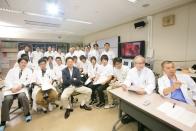| Neurosurgery |
| Director WAKABAYASHI, Toshihiko (Professor) 7E |
| Equipped with an advanced operating room, Brain Theater, and performing complex surgery |
| Our department has a long history; it was established by Professor Makoto Saito, the founder of the Japan Neurosurgical Society. Since then, our department has always been challenging the pioneering development of neurosurgery. |

Medical Care System
We strive to improve treatment results by developing state-of-the-art brain surgery devices, establishing new therapies through university-industry cooperation, and diagnosing intracerebral conditions and analyzing treatments using computer simulation models. We are also working to establish a system for quickly responding to thrombolysis by establishing a medical institution network in cooperation with the emergency medical service, to establish an organic system for treatment in cooperation with convalescent rehabilitation facilities for stroke patients and home medical care facilities, and to increase awareness of preventive medicine through brain checkups.
Target Disease
Various groups including the brain tumor group, the cerebro-endovascular surgery and stroke surgery group, the pituitary gland and neuroendoscopy group, the functional brain surgery and image analysis group, and the spinal cord and spine group provide medical care to patients with a wide range of diseases.
Strong Fields
High-precision image-guided navigation surgery for brain tumors, super advanced endovascular surgery and aneurysmal clipping for stroke, surgery for pituitary tumor and intraventricular surgery using neuroendoscope, stereotactic surgery for Parkinson's disease and essential tremor based on functional neurosurgery, surgery for intractable pain and epilepsy surgery, minimally invasive surgery for spinal diseases, and development of advanced medical care including nucleic acid technology by the advanced neurosurgery development group.
Clinical Results
The annual number of surgeries was 614; the number amounts to 10,581 if surgeries performed in affiliated hospitals (46 facilities) were included. The breakdown of a total of 19,976 inpatients according to diseases, including inpatients in affiliated hospitals, was as follows: 2,919 patients with a tumor, 2,134 patients with aneurysms, 3,203 patients with cerebral hemorrhage, 2,545 patients with cerebral infarction, 5,027 patients with head trauma, 1,110 patients with spinal disease, and 764 patients with functional neurosurgical disease (results in 2011).
Specialized Outpatient Clinic
Brain tumor; genetic, regenerative, and cell therapies; endovascular surgery; functional and epilepsy surgery; pituitary gland and endoscopic surgery; spinal cord and spine; peripheral nerve; stroke; rehabilitation for neural function recovery; and BMI.
Advanced Medicine and Research
Our department has adopted advancement in life science and medical engineering and performed the first gene therapy for brain tumor in Japan. In addition to making efforts to develop cellular and regenerative medicine and cerebro-endovascular treatment, we introduce new technologies in computer and diagnostic imaging to establish sophisticated surgical methods. Our department is equipped with an advanced operating room (Brain Theater), which fully uses intraoperative MRI and the high-accuracy navigation robot "Neuro Mate," which was introduced for the first time in Asia.










